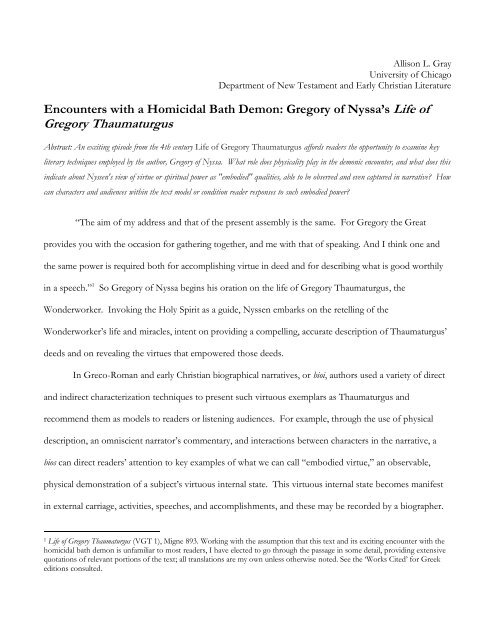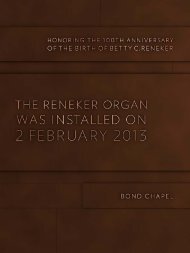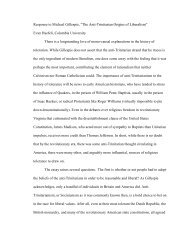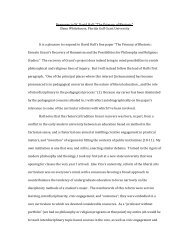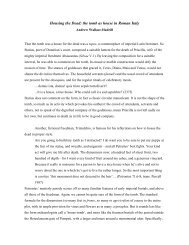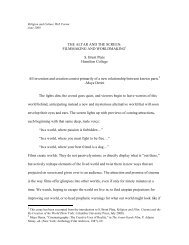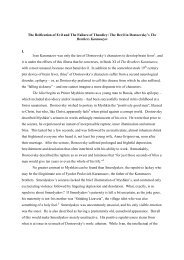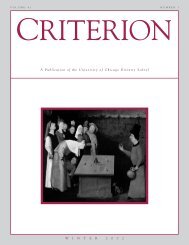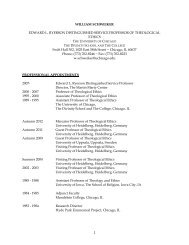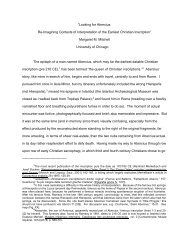Gregory Thaumaturgus - Divinity School - University of Chicago
Gregory Thaumaturgus - Divinity School - University of Chicago
Gregory Thaumaturgus - Divinity School - University of Chicago
You also want an ePaper? Increase the reach of your titles
YUMPU automatically turns print PDFs into web optimized ePapers that Google loves.
Allison L. Gray<br />
<strong>University</strong> <strong>of</strong> <strong>Chicago</strong><br />
Department <strong>of</strong> New Testament and Early Christian Literature<br />
Encounters with a Homicidal Bath Demon: <strong>Gregory</strong> <strong>of</strong> Nyssa’s Life <strong>of</strong><br />
<strong>Gregory</strong> <strong>Thaumaturgus</strong><br />
Abstract: An exciting episode from the 4th century Life <strong>of</strong> <strong>Gregory</strong> <strong>Thaumaturgus</strong> affords readers the opportunity to examine key<br />
literary techniques employed by the author, <strong>Gregory</strong> <strong>of</strong> Nyssa. What role does physicality play in the demonic encounter, and what does this<br />
indicate about Nyssen's view <strong>of</strong> virtue or spiritual power as "embodied" qualities, able to be observed and even captured in narrative? How<br />
can characters and audiences within the text model or condition reader responses to such embodied power?<br />
“The aim <strong>of</strong> my address and that <strong>of</strong> the present assembly is the same. For <strong>Gregory</strong> the Great<br />
provides you with the occasion for gathering together, and me with that <strong>of</strong> speaking. And I think one and<br />
the same power is required both for accomplishing virtue in deed and for describing what is good worthily<br />
in a speech.” 1<br />
So <strong>Gregory</strong> <strong>of</strong> Nyssa begins his oration on the life <strong>of</strong> <strong>Gregory</strong> <strong>Thaumaturgus</strong>, the<br />
Wonderworker. Invoking the Holy Spirit as a guide, Nyssen embarks on the retelling <strong>of</strong> the<br />
Wonderworker’s life and miracles, intent on providing a compelling, accurate description <strong>of</strong> <strong>Thaumaturgus</strong>’<br />
deeds and on revealing the virtues that empowered those deeds.<br />
In Greco-Roman and early Christian biographical narratives, or bioi, authors used a variety <strong>of</strong> direct<br />
and indirect characterization techniques to present such virtuous exemplars as <strong>Thaumaturgus</strong> and<br />
recommend them as models to readers or listening audiences. For example, through the use <strong>of</strong> physical<br />
description, an omniscient narrator’s commentary, and interactions between characters in the narrative, a<br />
bios can direct readers’ attention to key examples <strong>of</strong> what we can call “embodied virtue,” an observable,<br />
physical demonstration <strong>of</strong> a subject’s virtuous internal state. This virtuous internal state becomes manifest<br />
in external carriage, activities, speeches, and accomplishments, and these may be recorded by a biographer.<br />
1 Life <strong>of</strong> <strong>Gregory</strong> <strong>Thaumaturgus</strong> (VGT 1), Migne 893. Working with the assumption that this text and its exciting encounter with the<br />
homicidal bath demon is unfamiliar to most readers, I have elected to go through the passage in some detail, providing extensive<br />
quotations <strong>of</strong> relevant portions <strong>of</strong> the text; all translations are my own unless otherwise noted. See the ‘Works Cited’ for Greek<br />
editions consulted.
Bios’s main appeal from a pedagogical or catechetical standpoint is that embodied virtue thus preserved in<br />
text can be imitated and re-embodied by those who read about it. The fourth-century Cappadocian Father<br />
<strong>Gregory</strong> <strong>of</strong> Nyssa has three biographical narratives that work with the concept <strong>of</strong> embodied virtue in order<br />
to present virtuous exemplars to reading and listening audiences: The Life <strong>of</strong> Moses, a re-telling and allegorical<br />
interpretation <strong>of</strong> biblical narratives about the lawgiver; The Life <strong>of</strong> Macrina, an encomiastic account <strong>of</strong><br />
<strong>Gregory</strong>’s oldest sister’s birth, upbringing, admirable life, and noble death; and The Life <strong>of</strong> <strong>Gregory</strong><br />
<strong>Thaumaturgus</strong>, a lengthy oratorical presentation <strong>of</strong> <strong>Gregory</strong> the Wonderworker’s amazing feats and<br />
theological teachings. In each <strong>of</strong> these bioi, Nyssen describes, praises, allegorizes, and sometimes exploits his<br />
subjects’ physical bodies as sites through which readers can discern the subjects’ internal strengths. The<br />
works’ prefaces disclose <strong>Gregory</strong>’s didactic aims: each text not only illuminates but also recommends its<br />
subjects’ virtues to the audience as worthy <strong>of</strong> imitation. A close reading <strong>of</strong> the bath demon episode in the<br />
Life <strong>of</strong> <strong>Gregory</strong> <strong>Thaumaturgus</strong> (VGT) provides us with an opportunity to examine <strong>Gregory</strong> <strong>of</strong> Nyssa’s complex<br />
and multi-layered process <strong>of</strong> characterization, a crucial tool for narrating imitable embodied virtue.<br />
In this paper we will examine the episode from three perspectives, which we might think <strong>of</strong> as<br />
expanding concentric circles. First, tightly focused on the events <strong>of</strong> the narrative itself, we will see that<br />
<strong>Gregory</strong>’s use <strong>of</strong> detailed physical description has a variety <strong>of</strong> effects: it creates a vivid (and frankly<br />
frightening) sense <strong>of</strong> the narrative setting and atmosphere; it evokes the presence <strong>of</strong> his subject the<br />
Wonderworker even when this figure is not “on stage”; and it presents a manifestation <strong>of</strong> spiritual power<br />
that is decidedly material and expressed in the practitioner’s physical behaviors. This power can be<br />
perceived with the senses, recorded in narrative form, then revisited and re-experienced by reading and<br />
listening audiences. This observation about the repeated evocation <strong>of</strong> physical, sense experience through<br />
text leads us to the second critical perspective, examining the potential effects <strong>of</strong> characterization techniques<br />
on an ideal audience. We can trace the way <strong>Gregory</strong> tries to carefully control his audience’s vantage point<br />
and condition reader responses: how do characters on the level <strong>of</strong> the narrative react to the miraculous
events? What interpretations and behaviors does <strong>Gregory</strong> recommend for his audience? Finally, we may<br />
view the episode within <strong>Gregory</strong>’s wider literary corpus, as an example <strong>of</strong> the bios genre that is pr<strong>of</strong>oundly<br />
shaped by <strong>Gregory</strong>’s own theological and exegetical assumptions. After a careful examination <strong>of</strong> the<br />
demonic encounter, I will briefly outline some fruitful connections between the text - depicting spiritual<br />
power as embodied and imitable - and broader trends in Nyssen’s theological anthropology.<br />
The Text<br />
The bios’s subject is <strong>Gregory</strong> <strong>Thaumaturgus</strong>, also known as <strong>Gregory</strong> the Great, <strong>Gregory</strong> <strong>of</strong> Pontus,<br />
or “the Teacher.” He was born in Cappadocia ca. 210-215 CE into a pagan family. He intended to study<br />
law in Berytus (modern Beirut), the capital <strong>of</strong> legal studies in the Roman Near East, but instead attached<br />
himself to the school <strong>of</strong> Origen in Caesarea, studying there between 233 and 238 and converting to<br />
Christianity. 2<br />
Upon his subsequent return to Neocaesarea, he was appointed as its bishop and continued in<br />
that capacity until his death sometime between 270 and 275. 3<br />
He held the See during the Decian<br />
persecution <strong>of</strong> 250 and 251 and gained his privileged place as a beloved and fabled patron <strong>of</strong> Cappadocian<br />
Christianity through his evasion <strong>of</strong> persecutors and his protection <strong>of</strong> local Christians during this period. 4<br />
<strong>Thaumaturgus</strong>’ role as benefactor and protector is also the reason for his connection to <strong>Gregory</strong> <strong>of</strong> Nyssa,<br />
his older brother Basil <strong>of</strong> Caesarea, and their family: the Cappadocian Fathers both attribute the spiritual<br />
formation <strong>of</strong> their paternal grandmother, Macrina the Elder, to the Wonderworker’s influence. 5<br />
In his<br />
2 In <strong>Gregory</strong> the Wonderworker’s own writings, his theology appears not as fully worked out as Origen’s, nor does he express<br />
himself in consistent terms like his predecessor. Possible explanations for this are proposed by Slusser, including that the<br />
theological works are 1) exoteric and intended for uncatechized Christians, 2) composed early in <strong>Thaumaturgus</strong>’ life and therefore<br />
unsophisticated, or 3) simply reflective <strong>of</strong> <strong>Gregory</strong>’s own “rudimentary” grasp <strong>of</strong> Christian dogma (Slusser, 8-10). Lane Fox<br />
provides a brief but useful discussion <strong>of</strong> <strong>Gregory</strong>’s apparent relation to Origen’s works and known teaching methods in Pagans and<br />
Christians, 519-525. In any event, <strong>Gregory</strong> does not mention Jesus or the Holy Spirit very <strong>of</strong>ten, tends to treat the Incarnation as<br />
instrumental, and Abramowski and Slusser both point out that the sophisticated Creed is more likely to have been composed by<br />
<strong>Gregory</strong> <strong>of</strong> Nyssa than by the Wonderworker.<br />
3 Lane Fox gives approximate dates <strong>of</strong> 220-272 CE for <strong>Gregory</strong> <strong>Thaumaturgus</strong>’ life (Lane Fox, 516).<br />
4 Slusser 1-3. On the importance <strong>of</strong> Berytus as a center for legal studies in the period, see Fergus Millar, The Roman Near East, 31<br />
BC – AD 337.<br />
5 Van Dam 2003, 72-81 on <strong>Gregory</strong> and Basil’s reconstruction <strong>of</strong> a Christian landscape for Cappadocia, largely informed by their<br />
knowledge <strong>of</strong> <strong>Gregory</strong> <strong>Thaumaturgus</strong> and other figures, including those <strong>of</strong> legend (e.g. Longinus, centurion from the crucifixion,<br />
being <strong>of</strong> Cappadocian extraction).
Epistle 204, written to the people and bishops <strong>of</strong> Neocaesarea, Basil remarks on the kinship his family has<br />
with the entire congregation in that city and the resulting integrity <strong>of</strong> his family’s faith:<br />
What more prominent demonstration <strong>of</strong> our faith could there be than that we have<br />
been brought up by a blessed grandmother from your midst? I mean the famous<br />
Macrina, by whom we were taught the words <strong>of</strong> the most blessed <strong>Gregory</strong>, preserved<br />
for her by obedience <strong>of</strong> memory; she also guarded us, still young, and formed and<br />
shaped us with the doctrines <strong>of</strong> piety. 6<br />
Basil is seeking here to emphasize the bond between himself and the community in order to shore up his<br />
own reputation and counter attacks made by the Neocaesarean bishop Atarbios; nevertheless, his respect for<br />
the Wonderworker and his own ancestors seems genuine. 7 <strong>Gregory</strong>’s bios is a lengthy meditation on the life<br />
<strong>of</strong> <strong>Thaumaturgus</strong> and his effects on others’ faith.<br />
The VGT is one <strong>of</strong> Nyssen’s earlier compositions, delivered as an oration probably in Neocaesarea<br />
on <strong>Gregory</strong>’s feastday, November 17 th , in or after 381 CE. 8<br />
written version before making it available for circulation. 9<br />
He appears to have added some chapters to a<br />
When the text is mined for straightforward<br />
historical detail, a number <strong>of</strong> issues arise. Scholars generally accept that the account must rely, at least in<br />
part, on oral accounts from the region <strong>of</strong> Neocaesarea and that it thus provides access to very early<br />
traditions about the region’s founding saint. 10<br />
This idea is corroborated by the existence <strong>of</strong> other Lives in<br />
Latin, Syriac, and Armenian that appear to have used similar source material. 11<br />
However, Raymond Van<br />
Dam and Robin Lane Fox have convincingly shown that <strong>Gregory</strong> does not seem to know any <strong>of</strong><br />
<strong>Thaumaturgus</strong>’ own writings. 12<br />
In fact, the Creed attributed to <strong>Gregory</strong> <strong>Thaumaturgus</strong> and preserved in this<br />
bios was most likely composed by <strong>Gregory</strong> <strong>of</strong> Nyssa specifically for the oratorical occasion. Including this<br />
6 Epistle 204, Basil to the People <strong>of</strong> Neocaesarea, through their priests (375 CE). Translation from Barrois, 26.<br />
7 Nyssen’s great respect for the influence <strong>of</strong> Macrina the Elder certainly colors his introduction to the Life <strong>of</strong> Macrina. Van Dam,<br />
Families and Friends, describes Basil’s attitude toward his paternal grandparents on pp 16-18 especially.<br />
8 with Abramowski, based on the orthodox nature <strong>of</strong> the Creed and its prominent placement in the text as a means <strong>of</strong> legitimating<br />
<strong>Thaumaturgus</strong>’ spiritual authority. Van Dam 1982 argues for a date in 380 while Telfer gives no specific date but thinks the<br />
address was probably delivered in Pontus closer to Nyssen’s homebase <strong>of</strong> Annisa rather than in Neocaesarea itself (he suggests<br />
Ibora; Telfer 229).<br />
9 Added chapters would include the stories from VGT 98, Migne 956A on (see Slusser, 16).<br />
10 Slusser, 13-14.<br />
11 The Syriac is a 6 th century composition. Rufinus also includes some stories about <strong>Thaumaturgus</strong> in his Latin translation <strong>of</strong><br />
Eusebius’ Ecclesiastical History, though Rufinus’ source seems to be <strong>Gregory</strong> <strong>of</strong> Nyssa’s bios. (Telfer, 231).<br />
12 Van Dam 1982
creedal statement provided Nyssen a way <strong>of</strong> defending the Wonderworker’s orthodoxy by Nyssen’s<br />
contemporary standards (after the Council <strong>of</strong> Constantinople in 381). 13<br />
Despite its doubtful value as an<br />
accurate historical record <strong>of</strong> <strong>Thaumaturgus</strong>’ life and teachings, the bios nevertheless affords us a glimpse <strong>of</strong><br />
the Wonderworker’s late-fourth-century popular cult and provides an opportunity to watch <strong>Gregory</strong> <strong>of</strong><br />
Nyssa the biographer at work.<br />
The Episode & Physical Description<br />
To set the scene for the encounter with the homicidal bath demon, we begin with a wonder <strong>Gregory</strong><br />
<strong>Thaumaturgus</strong> performs much earlier in the story: banishing “demons” from a temple and converting its<br />
guardian to Christianity. It is <strong>Gregory</strong>’s first conquest <strong>of</strong> an external enemy. Of course, this is not counting<br />
his prior victories over all sorts <strong>of</strong> temptation and youthful folly, for “at a time when for others the soul is<br />
very slippery on account <strong>of</strong> ignorance, since the majority <strong>of</strong> youth easily slides down toward foolish and<br />
unpr<strong>of</strong>itable things… he was immediately complete in the acquisition <strong>of</strong> the virtues, always choosing what<br />
was useful for his age.” 14 As an adult, with these virtues in full bloom, he left his desert retreat and<br />
proceeded to a region “held fast by the deception <strong>of</strong> demons.” 15<br />
This ungenerous description <strong>of</strong> the Roman<br />
Cappadocian city <strong>of</strong> Neocaesarea probably reflects the real presence <strong>of</strong> pagan shrines and artwork in the<br />
urban landscape, but it also creates an ominous setting for <strong>Gregory</strong>’s procession into the city. Against this<br />
backdrop, the Wonderworker is said to be “like a noble soldier.” 16<br />
The martial metaphor anticipates a<br />
battle, while the qualification <strong>of</strong> this soldier’s superior, noble status foreshadows his eventual success.<br />
Undeterred by the obvious demonic possession <strong>of</strong> a certain temple’s custodians, he spends the night in the<br />
space, keeping a vigil <strong>of</strong> prayer and song that renders the demons impotent: the next morning, the<br />
13 Slusser, 8; Telfer, however, holds the Creed to be one <strong>of</strong> <strong>Thaumaturgus</strong>’ authentic compositions. If the Creed does have an<br />
historical kernel that was inscribed on the church in Neocaesarea, it was most likely a basic tripartite statement about the divine<br />
persons that Nyssen has significantly expanded. I am inclined to agree with Slusser, who suggests the simple form “One God,<br />
One Lord, One Holy Spirit, Perfect Trinity” (Slusser 55 n. 28); Lane Fox also argues for the historicity <strong>of</strong> such a formula (Lane<br />
Fox, 521).<br />
14 VGT 11, Migne 900C<br />
15 VGT 34, Migne 913<br />
16 VGT 34, Migne 913
custodians find that the demons are unable to perform their usual tricks because <strong>Gregory</strong> had spent the<br />
night in their sanctuary. One <strong>of</strong> the custodians, enraged but intrigued, convinces <strong>Gregory</strong> to perform a<br />
series <strong>of</strong> miraculous deeds to demonstrate his authority over the demons and prove his evangelical<br />
statement that “this [Christian] faith was not confirmed by arguments, but commanded assent by the<br />
wonders that had happened.” 17 <strong>Gregory</strong> commanded an enormous rock to relocate itself, and the custodian<br />
“straightaway believed in the word and left everything” in favor <strong>of</strong> “the association with the Great One and<br />
a share in his labors and that divine philosophy and instruction.” 18<br />
It is this same temple guardian who now serves as <strong>Gregory</strong>’s deacon and plays a starring role in our<br />
episode. The deacon accompanied the Thaumaturge when, as Nyssen recounts, <strong>Gregory</strong> wished to evade<br />
capture at the hands <strong>of</strong> persecutors. In case any members <strong>of</strong> the audience were tempted to use this flight as<br />
evidence <strong>of</strong> the Wonderworker’s cowardice, <strong>Gregory</strong> reports that it was, in fact, a demonstration <strong>of</strong> his deep<br />
regard for his fellow Christians:<br />
Then that Great One, seeing the weakness <strong>of</strong> human nature, how most people were<br />
unable to bear out the fight for piety to the point <strong>of</strong> death, became a counselor to<br />
the church to pull back a little from the fearful attack, thinking it better that by flight<br />
their souls should be preserved than that, by standing on the battle line, they should<br />
become deserters from the faith. And so that people might be as strongly persuaded<br />
as possible that it was no hazard for their soul to preserve their faith through flight,<br />
by his own example he became a counselor <strong>of</strong> retreat, since he himself withdrew<br />
before the others from the approach <strong>of</strong> danger. 19<br />
Returning to the narrative proper, we find that <strong>Gregory</strong> and the former temple guardian, now deacon, have<br />
made their way to a hilltop. Here the Wonderworker and his companion reenact a scene reminiscent <strong>of</strong> the<br />
Israelites’ battle against Amalek (Exod 17:8-16) and Jesus’ transfiguration (Mk 9:2-8 and parallels) in order<br />
to escape the notice <strong>of</strong> their pursuers:<br />
He, having ordered his companion to stand with firm and certain confidence facing<br />
God and to believe in salvation, holding up his hands in prayer, and not to let his<br />
faith be knocked out by fear even if the pursuers got very close, made himself an<br />
17 VGT 39, Migne 917B<br />
18 VGT 40, Migne 917C<br />
19 VGT 84, Migne 945D
example <strong>of</strong> that command for his deacon, looking to heaven with unwavering gaze<br />
and hands stretched in an upright position. And this is the way they stood. 20<br />
As in this episode, so throughout the bios <strong>Gregory</strong> <strong>of</strong> Nyssa continues to come back to Scripture in order to<br />
validate the Wonderworker’s power and characterize his exemplary qualities as biblically grounded. 21<br />
Standing completely still, with their internal belief and devotion truly embodied in the vertical gaze and hand<br />
position, they appear to their foiled enemies in the form <strong>of</strong> trees. Once explained, this miraculous event<br />
leads to the conversion <strong>of</strong> an astounded would-be informant, who abandons his persecuting goals.<br />
According to <strong>Gregory</strong>’s account, this incident confirmed the devotion <strong>of</strong> the Wonderworker’s<br />
followers and particularly <strong>of</strong> the temple custodian turned deacon. The young deacon commended himself<br />
to the Teacher’s protection by asking for his intercessory prayer and then went on his way. Arriving in a<br />
nearby city around evening time, he hoped to enjoy a bath after his travels. His desire for refreshment is<br />
vividly described as a wish to attend to his bodily fatigue (κόπος). But things were not so simple. As<br />
<strong>Gregory</strong> the narrator informs us, “a certain homicidal demon was in control <strong>of</strong> that place, who habitually<br />
visited the bath, whose destructive power was effective against those who came after dark, and for this<br />
reason that bath was unused and inactive after sunset.” 22<br />
To round out the fearsome picture, <strong>Gregory</strong> also<br />
20 VGT 85, Migne 948<br />
21 See especially the episode in VGT 73-75, Migne 941: two men attempt to deceive <strong>Gregory</strong>, with one <strong>of</strong> them lying in the road<br />
pretending to be dead. <strong>Gregory</strong> throws his cloak over the man’s prone body and the man actually does die. Nyssen claims this<br />
event shows that neither <strong>Gregory</strong> nor God is deceived, and he makes a direct comparison to Peter condemning Ananias to death<br />
for deceit (Acts 5:1-11). Other examples, some with explicit comparisons by Nyssen, include settling a dispute between two<br />
brothers with the wisdom <strong>of</strong> Solomon and the power <strong>of</strong> Moses in VGT 49-55, Migne 924-929 // 1 Kings 3:16-28 and Exodus<br />
14:15-22; casting out a demon in VGT 77, Migne 941-944 //Mk 9:14-29; <strong>Gregory</strong> praying in thanksgiving “like David” in VGT<br />
88, Migne 949 // Psalm 124:6.<br />
22 VGT 92, Migne 952; Bonner’s 1932 essay “Demons <strong>of</strong> the Bath” addresses another narrative with a haunted bath: the<br />
apocryphal Acts <strong>of</strong> John by Pseudo-Prochorus. In this case the homicidal demon is Satan himself, who habitually strangles or<br />
drowns (πνίγω) young people who attend the bath. However, this haunting is explained by the occurrence <strong>of</strong> a foundation<br />
sacrifice during the building <strong>of</strong> the bathhouse, and it is this horrible background that makes the space a suitable setting for<br />
demonic activity. There is no such backstory for <strong>Gregory</strong>’s evil bathhouse, but one important parallel remains; in both stories, the<br />
demon is able to use some bodily form and physical strength to attack his victims, suggesting an early Christian belief in embodied<br />
demonic forces.<br />
Since the Acts <strong>of</strong> John are typically believed to belong to the early fifth century CE, it is not impossible that Nyssen’s story about<br />
<strong>Gregory</strong> <strong>of</strong> <strong>Thaumaturgus</strong>, if circulated widely enough, might have influenced the Acts’ author (Bonner, 206). Bonner <strong>of</strong>fers a list<br />
<strong>of</strong> other early texts that deal with bath demons: most significantly three demonic sightings in baths from the Acts <strong>of</strong> Andrew (see<br />
also Klauck’s summary <strong>of</strong> the story in his The Apocryphal Acts <strong>of</strong> the Apostles: an Introduction, pp 113-140, and the note that the public
informs his readers that the bath’s doorman “testified that none <strong>of</strong> those who had dared it at that hour had<br />
returned from the water on his own two feet, but that the demon had overpowered them all after nightfall,<br />
and that many had already, out <strong>of</strong> ignorance, suffered fatal results; in place <strong>of</strong> the anticipated relaxation,<br />
laments and wailing had received them.” 23<br />
The double testimony <strong>of</strong> narrator and eyewitness sounds like the<br />
lead-in for every slasher horror film set in a youth hostel. But this detailed scene, evoking death through<br />
metonymy <strong>of</strong> reference to funeral accoutrements and mourning customs, plays an important role in<br />
highlighting the Wonderworker’s power: against a dark backdrop <strong>of</strong> nighttime inside the deserted bathhouse<br />
where we are told to expect a foul murder will occur, the brilliance <strong>of</strong> the deacon’s miraculous victory over<br />
the demon can shine more brightly.<br />
Events proceed as follows:<br />
When he was inside and naked, multiform kinds <strong>of</strong> frights and shapeless terrors were<br />
contrived by the demon: manifold apparitions showing the mingled nature <strong>of</strong> fire<br />
and smoke, in the shape <strong>of</strong> men and beasts, falling upon the eyes, sounding in the<br />
ears, pressing upon his breath, and pouring out in a circle around his body. Making<br />
the Sign upon himself and calling on the name <strong>of</strong> Christ, he traversed the first<br />
chamber unscathed. When he entered the inner one he met with more terrible<br />
sights, since the demon had been transformed into the most fearful apparition, and<br />
at the same time he thought the room was being shaken by an earthquake and the<br />
pavement beneath torn asunder to reveal the naked flame below, and that flaming<br />
sparks were being thrown up from the waters, and again the Sign was an adequate<br />
armor for him, and the name <strong>of</strong> Christ, and the aid furnished through the Teacher’s<br />
prayers scattered the terrors <strong>of</strong> the sights and happenings. When he had already left<br />
the water and was hastening for the exit he was again hindered, since the demon was<br />
holding the doors shut. Once again even this impediment was undone <strong>of</strong> its own<br />
accord through the same power, as the door withdrew for the Sign. But since he<br />
thought that everything had yielded to himself, it is said that the demon cried out to<br />
him with a human voice not to attribute to himself that power through which he had<br />
escaped destructions; for the voice <strong>of</strong> the one who had commended him to the<br />
protector had granted him the impassibility. 24<br />
The passage is dominated by detailed physical description <strong>of</strong> the setting, <strong>of</strong> the deacon’s subjective<br />
experience, and <strong>of</strong> his self-defense maneuvers. His progress through the various chambers <strong>of</strong> the bath is<br />
bathhouse is “a favorite lodging for demons,” p 121), Tertullian’s warning against demons in pools and baths from de Baptismo,<br />
and Psellus’ 11 th century De operatione daemonum.<br />
23 VGT 92, Migne 952<br />
24 VGT 93, Migne 952
also noted at several points, creating a clear impression <strong>of</strong> the tale’s setting. At each <strong>of</strong> its three stages, the<br />
terrible demonic attack is described primarily in terms <strong>of</strong> its physical effects on the deacon: in the first<br />
chamber, the eyes, ears, and breath are mentioned individually, and Nyssen ends with a summary comment<br />
about the encircling <strong>of</strong> the deacon’s whole vulnerable, naked body. The defensive response, in a<br />
complementary fashion, involves both oral and kinesthetic components. The deacon employs the sign <strong>of</strong><br />
the cross, marking himself with a distinct physical motion, while he speaks the name <strong>of</strong> Christ, and is thus<br />
able to move through the oppressive space without experiencing actual bodily damage. The protective force<br />
apparently infuses the areas <strong>of</strong> his body that were being pressed upon by the demon.<br />
In the second chamber, the demon’s manifestation seems stronger, with more extreme effects that<br />
target the entire bathhouse structure and threaten the deacon not with suffocation but with immolation:<br />
pronounced seismic activity ruptures the floor, and flying sparks emerge from the water in the chasm. In<br />
the face <strong>of</strong> all these unnatural obstacles, the deacon employs the same simple, physical action to defend<br />
himself. This time, however, to match the escalation <strong>of</strong> demonic activity, the sign or seal <strong>of</strong> the cross is<br />
actually compared to armor, and readers are asked to imagine the maneuver forming a virtually solid barrier<br />
between the deacon’s body and the force <strong>of</strong> the demon’s attacks. Simultaneously, Nyssen reminds readers<br />
<strong>of</strong> a stronger defensive power in the form <strong>of</strong> the Thaumaturge’s help. Even though the Wonderworker is<br />
still out in the countryside while all this activity is taking place in the city, it is his aid, transferred by means<br />
<strong>of</strong> intercessory prayer, that actively “scatters” or disperses the terrible visions and other events. <strong>Gregory</strong><br />
<strong>Thaumaturgus</strong>, whose physical stance in prayer became a means <strong>of</strong> disguise on a country hilltop, now sends<br />
his protective presence across a significant distance, and it is similarly effective.<br />
By the time the deacon and the demon face <strong>of</strong>f for their final showdown, the demon himself has<br />
adopted a physical form, becoming embodied enough to lay hold <strong>of</strong> the door (ἀντιλαμβάνω) and prevent<br />
egress. This time, the sign <strong>of</strong> the cross also has a stronger effect on the material world, expanding its<br />
influence even beyond the deacon’s body: it seems to empower the inanimate bathhouse door to fling itself
open. This physical action <strong>of</strong> marking the sign or seal <strong>of</strong> the cross on one’s body serves as a focal point in<br />
the narrative, a clear source <strong>of</strong> spiritual power that is, conveniently, a physical action that the story’s<br />
audience could easily imitate. We can perhaps imagine that while the story is being related, Nyssen building<br />
narrative tension and stirring up a palpable fear in his audience, listeners might begin crossing themselves in<br />
solidarity with the beleaguered deacon. Up to this point, it would seem that <strong>Gregory</strong> <strong>of</strong> Nyssa has<br />
succeeded in bringing his audience through a visceral experience, dragging them to the very edge <strong>of</strong> their<br />
seats.<br />
It seems an appropriate moment for us, then, to step back and consider just how this audience is<br />
also subtly invited to assess and identify with other characters in the tale.<br />
Characterization & the Reader’s Vantage Point<br />
Perhaps the most intriguing question is this: who does the work <strong>of</strong> interpreting the deacon’s actions<br />
and their significance? That is, what types <strong>of</strong> direct and indirect characterization does <strong>Gregory</strong> <strong>of</strong> Nyssa use<br />
to guide his audience through the story? How much interpretive range are readers really granted? For one<br />
answer, let’s turn to the final piece <strong>of</strong> our episode, the demon’s pronouncement as the deacon leaves the<br />
bathhouse. The demon himself performs a direct characterization <strong>of</strong> the deacon and <strong>of</strong> the Wonderworker<br />
in this speech. He points out that the deacon should not attribute the miraculous events to himself but<br />
instead to <strong>Gregory</strong> <strong>Thaumaturgus</strong>, specifically to that figure’s powerful prayer. It seems significant that in<br />
order to make this point, the demon cried out for the first time in a human voice, interacting with the<br />
deacon through the sense <strong>of</strong> hearing and taking on a less supernatural, perhaps less terrifying, way <strong>of</strong><br />
communicating key information. He delivered a warning against unwarranted pride: “But since [the deacon]<br />
thought that everything had yielded to himself, it is said that the demon cried out to him with a human voice<br />
not to attribute to himself that power through which he had escaped destructions; for the voice <strong>of</strong> the one<br />
who had commended him to the protector had granted him the impassibility.” 25<br />
<strong>Gregory</strong> <strong>of</strong> Nyssa uses the<br />
25 VGT 93, Migne 952
demon himself to do important interpretive work inside the passage. The one who was vanquished gives the<br />
most reliable testimony about who or what actually defeated him. If readers are interpreting correctly, then,<br />
they must identify with the interpreting demon!<br />
But that’s not all. In case anyone listening caught on to this invitation and did not want to accept<br />
demonic testimony, she could just back up to the phrase that introduces the demon’s words; here <strong>Gregory</strong><br />
the narrator informs us, “But since he thought that everything had yielded to himself, it is said that…” At<br />
least two things are going on in this introductory formula. First, <strong>Gregory</strong> exercises his omniscient point <strong>of</strong><br />
view to tell readers that the deacon had an interpretation <strong>of</strong> the events and that it was in need <strong>of</strong> correction.<br />
As far as interpretation goes, then, readers who had put themselves in the deacon’s shoes while he was<br />
battling the demon are told they should now distance themselves and find another, more authoritative guide<br />
to understanding the events. Although the deacon can embody spiritual power, he does not, apparently,<br />
embody good sense. Second, anyone who doubts <strong>Gregory</strong>’s omniscience gets reassuring evidence that he is<br />
working from a source <strong>of</strong> some kind: “it is said that” this demonic utterance took place. This neat transition<br />
from the demon-haunted bathhouse to the outside world thus <strong>of</strong>fers a whole complex <strong>of</strong> cues directing the<br />
readers’ gaze away from the previous vantage point inside the deacon’s physical experience and immediately<br />
toward the narrator-sanctioned interpretation <strong>of</strong> events.<br />
To follow up on this sharply focused analysis <strong>of</strong> the power displayed in the battle <strong>of</strong> the bathhouse,<br />
<strong>Gregory</strong> <strong>of</strong> Nyssa proceeds to explain the significance <strong>of</strong> the episode by describing various characters’<br />
responses to it and then applying his own ecclesiastical lens. We could say he is expanding the target now<br />
that he has made sure to mark its bullseye, giving readers a wider range <strong>of</strong> acceptable interpretive options<br />
that stem from the first, most correct remark on the event as a demonstration <strong>of</strong> the Wonderworker’s<br />
influence. Figures in the narrative recognize the dramatic and miraculous nature <strong>of</strong> the deacon’s demonic<br />
encounter. Nyssen explains how the bath’s usual operators reacted; the deacon “was a source <strong>of</strong>
consternation (ἔκπληξις) to the people who ran the place” 26 on the basis <strong>of</strong> his unprecedented survival <strong>of</strong><br />
a nighttime bath. These people are not just shocked witnesses; instead, they seem to be assimilated to a<br />
larger group when <strong>Gregory</strong> immediately writes about other miraculous events that had taken place in the<br />
city. The deacon runs around to consult others who have experienced miracles firsthand, all <strong>of</strong> them<br />
miracles that the Wonderworker had predicted from far <strong>of</strong>f. This reporting role is crucial for the<br />
preservation <strong>of</strong> any records about <strong>Thaumaturgus</strong>’ and others’ spiritual power, and Nyssen’s narrative seems<br />
to take it for granted that people who saw wonders would willingly testify about them. After finding out as<br />
much as he can about other wonders the Teacher knew about, the deacon eventually reports back to<br />
<strong>Thaumaturgus</strong>, <strong>of</strong>fering in his own person a living testimony to the idea that believers ought to flock to<br />
powerful spiritual teachers.<br />
The wider framing <strong>of</strong> the episode presents <strong>Gregory</strong> <strong>of</strong> Nyssa with another opportunity for<br />
characterization in his own narrative voice. Adopting the long historical view, he explains that the demonic<br />
encounter story should be read as a foundation narrative for an important ecclesiastical practice, that <strong>of</strong><br />
intercessory prayer. This very deacon “left to his own and to those to come later a common protection,<br />
namely, that each should commend himself to God through the priests.” 27<br />
So important was this<br />
contribution, the author argues, that “even now, throughout the church, but especially among them, the<br />
same saying (φωνή) is a memorial <strong>of</strong> the aid which helped that man then.” 28<br />
<strong>Gregory</strong> <strong>Thaumaturgus</strong><br />
becomes the spiritual model for a key element <strong>of</strong> priestly responsibility and authority, and <strong>Gregory</strong> <strong>of</strong> Nyssa<br />
extends to the whole Church the promise that the Wonderworker’s spiritual victory can be re-enacted.<br />
All <strong>of</strong> these characterization techniques – direct description <strong>of</strong> the subject, the narrator’s framing <strong>of</strong><br />
events, the assessments and reactions <strong>of</strong> other characters – work together to set up a further interpretive<br />
task, a task that belongs to the reader. It seems that the reader has been asked to put herself in the shoes <strong>of</strong><br />
26 VGT 94, Migne 952<br />
27 VGT 94, Migne 953<br />
28 VGT 94, Migne 953
the deacon experiencing the demonic encounter and is subsequently asked to choose which other characters<br />
to imitate. She can join the demon in tracing out the real spiritual authority behind a wonder. She can<br />
marvel along with the city’s inhabitants, a fairly straightforward reaction, but one that further seems to<br />
obligate her to broadcast news <strong>of</strong> the miraculous event. She can follow the example <strong>of</strong> the deacon and<br />
employ the protective sign <strong>of</strong> the cross, seek out testimony from other believers, or attach herself to a<br />
spiritual teacher. She can follow the devotional practice introduced into the broader church and request<br />
intercessory prayer.<br />
So to answer the question that opened this portion <strong>of</strong> the paper - who does the work <strong>of</strong> interpreting<br />
the deacon’s actions and their significance? – the work is divided at least three ways. <strong>Gregory</strong> the author<br />
controls the setting, the narrative pacing, and the framing <strong>of</strong> the story in an attempt to impose his preferred<br />
interpretive boundaries on the audience. The characters on the level <strong>of</strong> the narrative join him in this crusade<br />
to properly direct the reader’s gaze and provide appropriate interpretations <strong>of</strong> the events seen. Finally, the<br />
reader herself must take on the most important interpretive task: bringing the narrative lesson to life and<br />
embodying again the virtues, from courage to faith, that the narrative subject(s) modeled.<br />
Characterization and Theology<br />
We turn now to a very brief examination <strong>of</strong> ways in which this episode, with its focus on physical<br />
manifestations <strong>of</strong> spiritual power and its various techniques for guiding reader interpretation, may reflect<br />
<strong>Gregory</strong> <strong>of</strong> Nyssa’s broader ideas about anthropology and exegesis. I will present a few points <strong>of</strong> contact<br />
with his more explicit reflections on virtuous exemplars from another <strong>of</strong> <strong>Gregory</strong>’s bioi, The Life <strong>of</strong> Moses<br />
(VM), in the interest <strong>of</strong> suggesting that Nyssen’s biographical narratives are entertaining and engrossing<br />
without compromising their ability to be effective vehicles for catechesis.<br />
<strong>Gregory</strong>’s anthropology centers upon a concept <strong>of</strong> continuous human development. In fact, human<br />
change and development is, for the Cappadocian, never-ending. He begins with a God who is infinite and<br />
unchanging, who has created human beings that are limited and changeable. Working with a modified
Platonic view <strong>of</strong> the soul, <strong>Gregory</strong> asserts that created human beings can learn to correctly channel their<br />
passionate nature into a powerful desire for closeness to their creator God. Unlike his predecessor Origen,<br />
<strong>Gregory</strong> does not believe that a person’s desire for God can ever be sated, since the unlimited God will<br />
eternally be able to reveal more <strong>of</strong> Himself to the believer. 29<br />
For <strong>Gregory</strong>, the portrait <strong>of</strong> Paul in Philippians<br />
3:13, the man who is “continually stretching out (ἐπεκτείνω) toward what lies ahead,” epitomizes the goal<br />
<strong>of</strong> the changeable human in relation to the unchanging God; the person who can practice this epektasis<br />
participates in “the activity that should characterize man as a creature and, consequently, involved in<br />
change.” 30<br />
<strong>Gregory</strong>’s literary depictions <strong>of</strong> human life, his biographical narratives, thus contain discussions<br />
<strong>of</strong> development and formation <strong>of</strong> character over time and in response to new situations.<br />
The VM is actually written for the purpose <strong>of</strong> illustrating such advancement. A younger man,<br />
presumably training for the priesthood, requests advice about how to live a virtuous life, and <strong>Gregory</strong> says<br />
he will describe Moses, who learned and possessed perfect virtue. Near the beginning <strong>of</strong> the VM, he makes<br />
a broad statement about continual aspiration to the good and indicates for his young reader that the very<br />
desire to advance toward greater virtue is already “the perfection <strong>of</strong> human nature.” 31<br />
It is the desire <strong>of</strong> any<br />
rightly oriented human nature to seek advancement in virtue, and if <strong>Gregory</strong> can provide texts that describe<br />
virtuous individuals and present occasions for readers to imitate these subjects, his bioi are meeting an<br />
essential human need.<br />
Second, and not surprisingly, <strong>Gregory</strong> sees Scripture as the most reliable teacher for those seeking<br />
an education in virtue and epektasis. When <strong>Gregory</strong> begins his presentation <strong>of</strong> Moses’ life in VM I.10-15, he<br />
presents the Biblical exemplar as a model <strong>of</strong> virtue for all humans, but then makes a distinction as regards<br />
gender. In this way <strong>Gregory</strong> reinforces the significance <strong>of</strong> a physical category (what he calls gender but what<br />
most modern thinkers would refer to as biological sex) for the embodied manifestation <strong>of</strong> virtue in his own<br />
29 On <strong>Gregory</strong>’s position vis-à-vis Plato and Origen, see Heine, 36.<br />
30 Heine, 93.<br />
31 VM I.10
day. His text becomes a point <strong>of</strong> triangulation between Scriptural realities and contemporary life, a place<br />
where proper Scriptural interpretation is necessary for right living. He insists that a Scriptural education can<br />
implant virtue in the human soul, regardless <strong>of</strong> gender and historical circumstances. It is Scripture, he says,<br />
that furnishes its readers with the models for imitation. He goes on to make even more clearly his point<br />
about men and women being differentiated but both furnished with Scriptural guidance:<br />
Since human nature is divided among female and male, and to both equally is<br />
presented the free choice between virtue and evil, for this reason to each group the<br />
corresponding example has been presented by the divine voice, so that with each<br />
looking to the cognate - the men to Abraham, the women to Sarah - both might be<br />
directed to the virtuous life by means <strong>of</strong> the appropriate examples. 32<br />
That is to say, the central text <strong>of</strong> Christian education is already geared toward helping humans fulfill their<br />
fundamental role as changeable beings continually reaching out toward the unchanging God. Those who<br />
know how to read Scripture – a skill <strong>Gregory</strong> can teach with his allegorical interpretation <strong>of</strong> Moses’ life –<br />
will find a reliable guide toward the divine.<br />
Finally, Scripture is the best but not the only “text” that can be interpreted to point readers toward<br />
the virtuous path. Creation itself gives indirect access to the divine by being a manifestation <strong>of</strong> divine<br />
activities (ἐνέργειαι). Human senses cannot access the divine nature (οὐσία) directly, but the senses can<br />
perceive the results <strong>of</strong> divine activity and learn something about the proper relation between humans and<br />
God, namely faith. 33<br />
Similarly, the activities and behaviors <strong>of</strong> a human being, which stem from his internal<br />
character, do not provide direct access to his actual character, but can hint at qualities that do exist in that<br />
character and teach something about the proper relation between humans and the world, namely virtuous<br />
living. The bios literary form provides readers with access to its subject’s body in action, to demonstrations<br />
<strong>of</strong> embodied virtue, and thus to virtue. It is no accident that each <strong>of</strong> <strong>Gregory</strong>’s bioi seems to focus on a<br />
32 VM 1.12<br />
33 Meredith 1999, 94.
particular virtue and presents a whole variety <strong>of</strong> instances in which the subject models ways to embody that<br />
virtue.<br />
Concluding Thoughts<br />
The deacon’s encounter with and victory over the homicidal bath demon contains the essential<br />
elements for helping audiences embark on the path <strong>of</strong> continual advancement in virtue. Readers receive a<br />
clear, detailed portrait <strong>of</strong> physical circumstances that resonates with their own experiences <strong>of</strong> fear and<br />
protection, even if none <strong>of</strong> them will ever face down a fiery demon in a haunted bathhouse. <strong>Gregory</strong> uses<br />
several narrative techniques to direct the reader’s gaze such that his audience is shown how to correctly<br />
“read” the deacon’s situation and learn its significance, a significance that touched immediate participants<br />
and <strong>Gregory</strong>’s contemporary period in equally powerful ways. Ultimately, he lays out a script for types <strong>of</strong><br />
behavior members <strong>of</strong> his audience can practice to mimic the deacon’s and the Wonderworker’s spiritual<br />
power in their own physical settings. Having been guided through the interpretive process, an ideal reader is<br />
now equipped to understand other demonstrations <strong>of</strong> embodied virtue, take specific and universal lessons<br />
from these, and themselves embody such virtues in their own lives.
Works Cited<br />
Abramowski, Luise. “Das Bekenntnis des Gregor <strong>Thaumaturgus</strong> bei Gregor von Nyssa und das Problem<br />
seiner Echtheit.” Zeitschrift für Kirchengeschichte vol. 87 no. 2 (1976). pp 145-166.<br />
Barrois, Georges A. The Fathers Speak: St. Basil the Great, St. <strong>Gregory</strong> <strong>of</strong> Nazianzus, St. <strong>Gregory</strong> <strong>of</strong> Nyssa, selected<br />
letters and life-records. Crestwood, NY: St. Vladimir’s Seminary Press, 1986.<br />
Bonner, Campbell. “Demons <strong>of</strong> the Bath.” Studies Presented to F. Ll. Griffith. London: Oxford <strong>University</strong><br />
Press, 1932. pp 203-208.<br />
Heine, Ronald E. Perfection in the Virtuous Life: a study in the relationship between edification and polemical theology in<br />
<strong>Gregory</strong> <strong>of</strong> Nyssa’s De vita Moysis. Patristic monograph series, no. 2. Cambridge, Mass: Philadelphia<br />
Patristic Foundation, 1975.<br />
Klauck, Hans-Josef. The Apocryphal Acts <strong>of</strong> the Apostles: an Introduction, transl. Brian McNeil. Waco, Texas:<br />
Baylor <strong>University</strong> Press, 2008.<br />
Laird, Martin S. <strong>Gregory</strong> <strong>of</strong> Nyssa and the grasp <strong>of</strong> faith: union, knowledge, and divine presence. Oxford: Oxford<br />
<strong>University</strong> Press, 2004.<br />
Lane Fox, Robin. Pagans and Christians. London: Penguin Books, 1986.<br />
Meredith, Anthony. <strong>Gregory</strong> <strong>of</strong> Nyssa. New York: Routledge, 1999.<br />
__________. The Cappadocians. Crestwood, NY: St. Vladimir’s Seminary Press, 1995.<br />
Migne, Jacques-Paul. Patrologia cursus completus: Series Graeca, vol. 10. Paris: J.P. Migne, 1857-1889.<br />
Millar, Fergus. The Roman Near East: 31 BC – AD 337. Cambridge MA: 1993.<br />
Radde-Gallwitz, Andrew. Basil <strong>of</strong> Caesarea, <strong>Gregory</strong> <strong>of</strong> Nyssa, and the Transformation <strong>of</strong> Divine Simplicity. Oxford:<br />
Oxford <strong>University</strong> Press, 2009.<br />
Silvas, Anna M. <strong>Gregory</strong> <strong>of</strong> Nyssa: The Letters. Introduction, Translation and Commentary. Supplements to Vigiliae<br />
Christianae vol. 83. Leiden: Brill, 2007.<br />
Slusser, Michael. St. <strong>Gregory</strong> <strong>Thaumaturgus</strong>: Life and Works. The Fathers <strong>of</strong> the Church, a new translation, vol.<br />
98. Washington, D.C.: The Catholic <strong>University</strong> <strong>of</strong> America Press, 1998.<br />
Telfer, William. “The Cultus <strong>of</strong> St. <strong>Gregory</strong> <strong>Thaumaturgus</strong>.” Harvard Theological Review vol. 29 no. 4 (1936),<br />
pp 225-344.<br />
Van Dam, Raymond. Becoming Christian: the Conversion <strong>of</strong> Roman Cappadocia. Philadelphia: <strong>University</strong> <strong>of</strong><br />
Pennsylvania Press, 2003.<br />
__________. Families and Friends in Late Roman Cappadocia. Philadelphia: <strong>University</strong> <strong>of</strong> Pennsylvania Press,<br />
2003.
__________. “Hagiography and History: The Life <strong>of</strong> <strong>Gregory</strong> <strong>Thaumaturgus</strong>.” Classical Antiquity vol. 1<br />
(1982), pp 272-308.<br />
__________. Kingdom <strong>of</strong> Snow: Roman Rule and Greek Culture in Cappadocia. Philadephia: <strong>University</strong> <strong>of</strong><br />
Pennsylvania Press, 2002.


